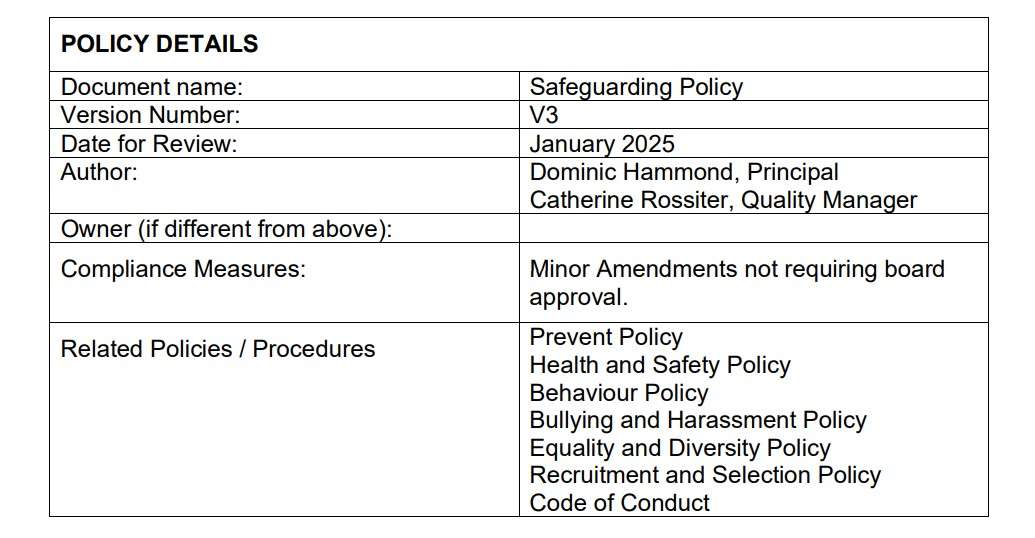1 Introduction
1.1 The welfare of our students is paramount. All children and vulnerable adults whatever age, culture, disability, gender, ethnic origin, religious beliefs and/or sexual identity have the right to protection from abuse. All suspicions and allegations of abuse will be taken seriously and responded to swiftly and appropriately by Results Consortium Limited (thereafter the College).
1.2 The College is fully committed to providing a learning and working environment that is free from abuse and harm
1.3 The College will strive to maintain a safe culture within all its learning and work environments by:
• clearly identifying and communicating the roles and responsibilities within the organisation for safeguarding
• having a clear auditable procedure in place
• training staff in safeguarding procedures
• allocating sufficient resources to safeguarding
• applying zero tolerance to any form of abuse and harm.
1.4 The purpose of this Policy is to set out the College’s approach to safeguarding of children and vulnerable adults. This policy is also designed to protect staff against false allegations.
2. Definitions
2.1 The Children Act 1989 and 2004 defines a ‘child’ as a person under the age of 18.
2.2 The Safeguarding Vulnerable Groups Act 2006 defines a ‘vulnerable adult’ as a person aged 18 and over, and;
• receiving a social care service
• receiving a health service
• living in sheltered accommodation
• detained in custody or under a probation order
• requiring assistance in the conduct of their affairs
• receiving a service, or participating in an activity, targeted at older people
• disabled, or with physical or mental health conditions
2.3 Abuse is a term to describe ways in which children and vulnerable adults are harmed, usually (but not always) by adults and often by people they know and trust. It refers to the damage done to a child or vulnerable adult’s physical or mental health and wellbeing. Abuse can occur within or outside the family, including a place of learning or training. Newly identified forms of abuse and trends in types of abuse mean our policies and procedures need to be continually reviewed.
3 Procedures and Principles
3.1 Safeguarding and promoting welfare is everyone’s responsibility.
3.2 All employees, directors, board members, partners and other stakeholders have a responsibility to actively make the environment a safe and secure place for all.
3.3 All staff must be familiar with this policy and the procedures by which we report and manage safeguarding concerns. All staff must be:
• receptive to any disclosures from students and alert to possible signs of abuse or self-harm
• familiar with the Staff Code of Conduct and demonstrate high standards in their professional behaviours
• compliant with mandatory safeguarding training, completing updates and attending additional safeguarding related training as required
• current with their working knowledge of Keeping Children Safe in Education (KCSIE) updates
3.4 The College will clearly identify a Designated Safeguarding Lead (DSL), their location and contact details in formats that are easily accessible to all staff and learners. There will be a deputy in case of sickness, annual leave or in the event of an allegation made against the DSL.
3.5 The College is committed to a policy in which:
3.5.1 Recruitment procedures comply with safeguarding best practice and will be followed in the appointment of all staff. Where staff are required to have contact with children or vulnerable adults, the College will only recruit or appoint staff who are deemed suitable to work with children or vulnerable adults.
3.5.2 All new employees will be made aware of and issued with this policy as part of their induction.
3.5.3 Any member of staff found in breach of the guidance will be subject to disciplinary procedures
3.5.4 All new members of staff and students who are under the age of 18 will have a Young Person’s Risk Assessment carried out as per the Health and Safety Policy.
3.5.5 All new students will be shown the Safeguarding Policy during induction. This will be followed by a discussion and checking of understanding. Understanding will be periodically reviewed.
3.5.6 All children and vulnerable adults within the organisation will be informed that their assessor or tutor will be their nominated contact point for any concerns they may have regarding safeguarding. In addition, they will be given details of the DSL, and asked to report any concerns to their assessor or tutor, or DSL.
3.5.7 The assessors and tutors must liaise with the DSL or any relevant partner organisations with any concerns to ensure safeguarding.
3.5.8 Staff must keep a secure and up to date record of all children and vulnerable adults learning or working in the organisation. They should monitor their progress on a regular basis to check they are safe from abuse and harm whilst on programme, or in a Results-based placement, internship or employment.
3.6 The college will comply with all current data protection legislation by ensuring that all student data in relation to safeguarding is processed in a lawful manner, and seeking to maintain student confidentiality wherever possible.
3.7 The College will always prioritise the sharing of information when this is deemed necessary to keep students safe. In accordance with good practice guidelines, and to ensure that notes and records continue to be available to support

